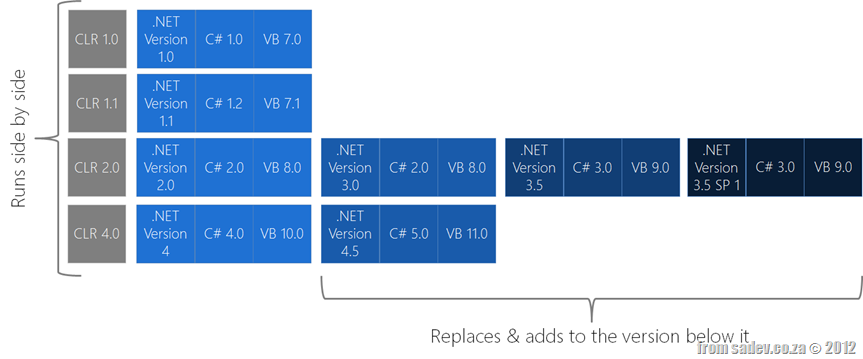tl;dr
- .NET 4.5 – 8th major release.
- .NET 4.5 is an in place replacement of .NET 4.0.
- Installing it could cause issues for .NET 4.0, but is very unlikely and likely shows your app is using undocumented features or using features incorrectly.
- .NET vesions, CLR versions & language versions are not in sync.
- There is an awesome chart below which makes it easy to see the relationships in the ecosystem.
Introduction
.NET 4.5 is the next release and it is important to take a look how it fits in the .NET ecosystem. This is the 8th major release of .NET! What do I mean by major release? I mean any release that is not a patch/support only release, or put another way a major release it included major new features in the CLR and/or a new language options.
SxS vs. Replacement
In .NET we are lucky that many versions can run side by side (SxS) provided they have different versions of the CLR, however if a new major release shares the same CLR it is a replacement/additive version. For example: .NET 3.0 used the same CLR as .NET 2.0 (the CLR 2.0) and when installed replaced many of the files in .NET 2.0 with new versions and it is only via compiler directives that some things are turned on and off. The advantage of the SxS model is installing a new version doesn’t influence apps on the previous version in any way (i.e. if the app is 1.1 and works fine before .NET 2.0 was installed, it will keep working fine after .NET 2.0 is installed).
The problem with replacement model is that there is a chance that installing a new version breaks apps on the original version – however Microsoft does a RIDICULOUS number of testing to make sure this doesn’t happen, so that chance is very small. In fact if you happen to hit one, the chance is higher you are using undocumented features or using features incorrectly.
The reason for this explanation of SxS vs. replacement is that .NET 4.5 is an in place replacement for .NET 4.
Version Naming
Part of the confusion I suspect around me saying that .NET 4.5 is the eighth release is because Microsoft naming of versions is about as far from logic as you can get – the worst examples are the .NET Version 3.5 SP 1 is a major release labelled a Service Pack 1?! and the fact we do not have a version 3 of the CLR, it was just skipped?!
The other aspect is that versions of the CLR, versions of the Framework and versions of the languages are completely out of sync, so .NET 4.5 runs on the CLR version 4 and we write code in C# version 5.0 or VB version 11.0 – cause that makes sense :S
Awesome Poster
Here is an awesome poster to help remind you of all the above!

